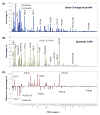Development of a synthetic PCB mixture resembling the average polychlorinated biphenyl profile in Chicago air
- PMID: 19375801
- PMCID: PMC2888912
- DOI: 10.1016/j.envint.2009.03.003
Development of a synthetic PCB mixture resembling the average polychlorinated biphenyl profile in Chicago air
Abstract
Studies of environmental and toxic effects of polychlorinated biphenyls (PCBs) are ideally performed with PCB mixtures reflecting the composition of environmental PCB profiles to mimic actual effects and to account for complex interactions among individual PCB congeners. Unfortunately, only a few laboratory studies employing synthetic PCB mixtures have been reported, in part because of the challenges associated with the preparation of complex PCB mixtures containing many individual PCB congeners. The objective of this study was to develop a PCB mixture that resembles the average PCB profile recorded from 1996 to 2002 at a satellite station of the Integrated Atmospheric Deposition Network located at the Illinois Institute of Technology (IIT) in Chicago, Illinois, using commercial PCB mixtures. Initial simulations, using published Aroclor profiles, showed that a mixture containing 65% Aroclor 1242 and 35% Aroclor 1254 was a good approximation of the target profile. A synthetic Chicago air mixture (CAM) was prepared by mixing the respective Aroclors in this ratio, followed by GC/MS/MS analysis. Comparison of the PCB profile of the synthetic mixture with the target profile suggests that the synthetic PCB mixture is a good approximation of the average IIT Chicago air profiles (similarity coefficient cos θ = 0.82; average relative percent difference = 84%). The synthetic CAM was also a reasonable approximation of the average of 184 PCB profiles analyzed in 2007 at 37 sites throughout Chicago as part of the University of Iowa Superfund Basic Research Program (isbrp), with a cos θ of 0.70 and an average relative percent difference of 118%. While the CAM and the two Chicago air profiles contained primarily di- to pentachlorobiphenyls, higher chlorinated congeners, including congeners with seven or eight chlorine atoms, were underrepresented in the synthetic CAM. The calculated TCDD toxic equivalency quotients of the synthetic CAM (2.7 ng/mg PCB) and the IIT Chicago air profile (1.6 ng/mg PCB) were comparable, but lower by two orders of magnitude than the isbrp Chicago air profile (865 ng/mg PCB) due to surprisingly high PCB 126 levels in Chicago air. In contrast, the calculated neurotoxic equivalency quotients of the CAM (0.33 mg/mg PCB) and the two Chicago air profiles (0.44 and 0.30 mg/mg PCB, respectively) were similar. This study demonstrates the challenges and methods of creating and characterizing synthetic, environmental mixtures of PCBs.
Copyright © 2009 Elsevier Ltd. All rights reserved.
Figures







Similar articles
-
Distinguishing Aroclor and non-Aroclor sources to Chicago Air.Sci Total Environ. 2022 Jun 1;823:153263. doi: 10.1016/j.scitotenv.2022.153263. Epub 2022 Jan 21. Sci Total Environ. 2022. PMID: 35066038 Free PMC article.
-
Discovery of non-aroclor PCB (3,3'-dichlorobiphenyl) in Chicago air.Environ Sci Technol. 2008 Nov 1;42(21):7873-7. doi: 10.1021/es801823r. Environ Sci Technol. 2008. PMID: 19031874 Free PMC article.
-
Intracity occurrence and distribution of airborne PCB congeners in Chicago.Sci Total Environ. 2022 Mar 15;812:151505. doi: 10.1016/j.scitotenv.2021.151505. Epub 2021 Nov 8. Sci Total Environ. 2022. PMID: 34762940 Free PMC article.
-
Polychlorinated biphenyls (PCBs): environmental impact, biochemical and toxic responses, and implications for risk assessment.Crit Rev Toxicol. 1994;24(2):87-149. doi: 10.3109/10408449409049308. Crit Rev Toxicol. 1994. PMID: 8037844 Review.
-
Comprehensive compilation of congener profiles to support health assessment of environmental exposures to polychlorinated biphenyl mixtures.Environ Res. 2024 Dec 15;263(Pt 1):120081. doi: 10.1016/j.envres.2024.120081. Epub 2024 Sep 28. Environ Res. 2024. PMID: 39343341 Review.
Cited by
-
Subchronic inhalation exposure study of an airborne polychlorinated biphenyl mixture resembling the Chicago ambient air congener profile.Environ Sci Technol. 2012 Sep 4;46(17):9653-62. doi: 10.1021/es301129h. Epub 2012 Aug 24. Environ Sci Technol. 2012. PMID: 22846166 Free PMC article.
-
Metabolic activation of WHO-congeners PCB28, 52, and 101 by human CYP2A6: evidence from in vitro and in vivo experiments.Arch Toxicol. 2024 Nov;98(11):3739-3753. doi: 10.1007/s00204-024-03836-w. Epub 2024 Aug 13. Arch Toxicol. 2024. PMID: 39136732 Free PMC article.
-
Gut Microbiota Modulates Interactions Between Polychlorinated Biphenyls and Bile Acid Homeostasis.Toxicol Sci. 2018 Dec 1;166(2):269-287. doi: 10.1093/toxsci/kfy208. Toxicol Sci. 2018. PMID: 30496569 Free PMC article.
-
Metabolism of 3-Chlorobiphenyl (PCB 2) in a Human-Relevant Cell Line: Evidence of Dechlorinated Metabolites.Environ Sci Technol. 2022 Sep 6;56(17):12460-12472. doi: 10.1021/acs.est.2c03687. Epub 2022 Aug 22. Environ Sci Technol. 2022. PMID: 35994059 Free PMC article.
-
Spatial distribution of airborne polychlorinated biphenyls in Cleveland, Ohio and Chicago, Illinois.Environ Sci Technol. 2010 Apr 15;44(8):2797-802. doi: 10.1021/es901691s. Environ Sci Technol. 2010. PMID: 20384374 Free PMC article.
References
-
- Altmann L, Mundy WR, Ward TR, Fastabend A, Lilienthal H. Developmental exposure of rats to a reconstituted PCB mixture or Aroclor 1254: effects on long-term potentiation and [3H]MK-801 binding in occipital cortex and hippocampus. Toxicol Sci. 2001;61:321–330. - PubMed
-
- Amaro AR, Oakley GG, Bauer U, Spielmann HP, Robertson LW. Metabolic activation of PCBs to quinones: Reactivity toward nitrogen and sulfur nucleophiles and influence of superoxide dismutase. Chem Res Toxicol. 1996;9:623–629. - PubMed
-
- Arif JM, Lehmler HJ, Robertson LW, Gupta RC. Interaction of benzoquinone- and hydroquinone-derivatives of lower chlorinated biphenyls with DNA and nucleotides in vitro. Chem Biol Interact. 2003;142:307–316. - PubMed
-
- Bandiera S, Safe S, Okey AB. Binding of polychlorinated biphenyls classified as either phenobarbitone, 3-methylcholanthrene or mixed-type inducers to cytosolic Ah receptor. Chem Biol Interact. 1982;39:259–277. - PubMed
-
- Cochran JW, Frame GM. Recent developments in the high-resolution gas chromatography of polychlorinated biphenyls. J Chromatogr A. 1999;843:323–368. - PubMed
Publication types
MeSH terms
Substances
Grants and funding
LinkOut - more resources
Full Text Sources
Miscellaneous

